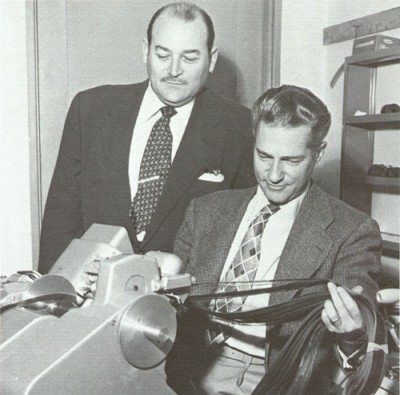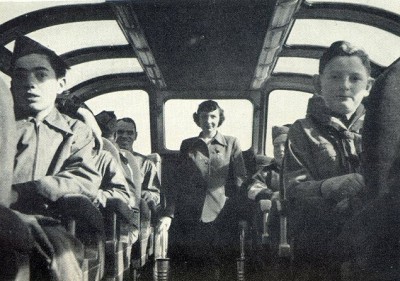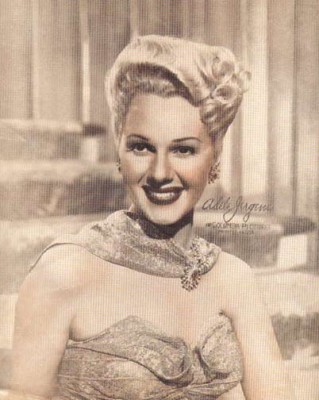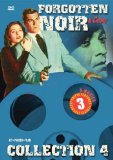| Reviews & Columns |
|
Reviews DVD TV on DVD Blu-ray 4K UHD International DVDs In Theaters Reviews by Studio Video Games Features Collector Series DVDs Easter Egg Database Interviews DVD Talk Radio Feature Articles Columns Anime Talk DVD Savant Horror DVDs The M.O.D. Squad Art House HD Talk Silent DVD
|
DVD Talk Forum |
|
|
| Resources |
|
DVD Price Search Customer Service #'s RCE Info Links |
|
Columns
|
|
|
Forgotten Noir & Crime Collection 4 (Western Pacific Agent / Highway 13 / Treasure of Monte Cristo / and more!)
Though the transfers and prints aren't perfect, they are generally quite good, most having come from British sources. (The British Film Institute is credited on one, while others carry the Exclusive Films distribution logo, the one-time parent company of Hammer Films.) Included in this set are: Counterspy meets Scotland Yard (Columbia, 1950), Radar Secret Service (Lippert, 1950), Motor Patrol (Lippert, 1950), Mr. District Attorney (Republic, 1941), Western Pacific Agent (Lippert, 1950), Highway 13 (1948, Screen Guild Productions), Treasure of Monte Cristo (Lippert, 1949), Roaring City (Lippert, 1951), and Sky Liner (Lippert, 1949).These aren't at all crummy-looking public domain titles in the Alpha Video sense, but movies legitimately acquired by VCI and/or Kit Parker Films. Kit Parker apparently owns the Screen Guild-Lippert Library (it was the same company, just as Monogram became Allied Artists); Counterspy and Mr. District Attorney seem to have been acquired through radio writer Phillips Lord's estate. The set retails for just $29.99 and while there's little in the way of extra features, that still comes out to just $3.33 per movie.
Robert Lippert (L) with editor Elmo Williams
Counterspy meets Scotland Yard is a surprisingly taut espionage procedural seemingly influenced by the semi-documentary-meets-noir style of The House on 92nd Street. Based on the long-running (1942-57) radio series Counterspy and a follow-up to David Harding, Counterspy (also released in 1950), the film stars Howard St. John, who's like a combo Lloyd Nolan - Walter Winchell. Possibly because St. John was middle-aged and craggy-faced, all the legwork into this investigation of a leak at a top secret missile base is handled by Scotland Yard agent Simon Langton (Australian Ron Randell).
This 67-minute film really hums. Early on it's revealed that a section chief's secretary, Karen Michelle (Gunsmoke's Amanda Blake), has unwittingly been passing information under hypnosis to foreign agent Hugo Borne (Lewis Martin), who with his especially sneaky fellow traveler Barbara (June Vincent), has assumed the identity of a kindly local doctor. (Martin is best remembered today as the saintly minister in George Pal's War of the Worlds. Those who know him only for that film will find his activities here unsettling.)
It's a crackling little picture, full of authentic-feeling investigation techniques and dialogue (helped by a good cast including John Dehner as an agent and John Douchette as one of the evil spies), and the climax is actually quite suspenseful for such a cheap, throwaway picture, making this a minor discovery. (*** 1/2)
The same, alas, can not be said of Radar Secret Service, which offers more action but less interesting characters, and a lot less realism. Though produced by Lippert, it plays a lot like a latter-day Republic serial extended to feature length, and even boasts a lot of serial talent in the cast.
This borderline sci-fi story involves the theft of a big supply of Uranium-238 by gangsters, among them Detour's Tom Neal as Mickey Moran - with a name like that, what could he be but a gangster? - and perennial Lippert comedy relief Sid Melton as Pill Box, who cracks jokes non-stop but is about as threatening as Buffalo Bob Smith. Mickey's gal is lusciously beautiful Lila (Adele Jergens), but she's already dumped him for the plot's ringleader, the mysterious Michael (Tristram Coffin, former Rocket Man).
Meanwhile, Secret Service agent Bill Travis (John Howard) and partner Static (Ralph Byrd of Dick Tracy fame; there's an inside joke to his familiar role), thanks to the miracle of radar, use their gee-whiz technology to track down the stolen uranium.
Though the cast is fun and the film is full of incident, the picture lacks focus: equal screentime is accorded to Howard, Neal, and Jergens & Coffin, and there's no single character to latch onto. Worse, the film has an almost Captain Video naiveté about technology. In Radar Secret Service, radar can do just about anything, including deliver perfectly-transmitted images from all over the county, like a remote television broadcast. One has to wonder whether the film ran out of money during production. The climax seems cut short, and the audience doesn't even get to see Jergens and Coffin get their hard-earned comeuppance. (**)
Motor Patrol starts out as yet another semi-documentary police procedural in the vein of films like He Walked by Night and the hit radio drama Dragnet, which debuted about six months before this was shot. Like Dragnet it touts considerable cooperation from the Los Angeles Police Department and there's lots of interesting footage in and nearby their Police Academy in Elysian Park.
The story involves the murder of a motorcycle cop (Bill Henry), the brother of a young woman (Jane Nigh) engaged to a cadet, Ken Foster (Don Castle, already 33 when this was made). Clues lead to a garage (at Normandie & 8th) where stolen cars are being chopped and resold through a crooked car dealership. Ken Foster goes undercover as a Chicago gangster looking to move lots of stolen cars, though the main mechanic (Col. Flack's Frank Jenks) is suspicious.
The no-star cast - you know pickings are slim when the most recognizable names are Reed Hadley, Onslow Stevens (as detectives), and the ubiquitous Sid Melton (as a comical hash-slinger) - is disappointing, though Castle is okay, somewhat reminiscent of George Murphy in Border Incident or Mark Stevens in The Street with No Name. Better is the authenticity of the police academy scenes and the early motorcycle patrolling and investigation.
Oddball Footnote: In what surely must be a mistake, the IMDb lists prolific Italian director Lucio Fulci in the cast as "Officer Tom Morgan" (as Louis Fuller). I find this very hard to believe. Lance Fuller maybe. Even Dolores Fuller perhaps, but...Lucio Fulci!? (***)
Kit Parker's release of a British Film Institute sourced print of Mr. District Attorney reportedly is the first time since about 1946 that the film has been available in its complete, 69-minute form. Presumably, like myriad other Republic titles, this was cut down to 52 minutes or so for release on television. Unfortunately, it plays like a half-baked His Girl Friday, and features Peter Lorre in one of the worst roles of his career.
Like Counterspy meets Scotland Yard, this was based on a radio series created by Phillips Lord. I've never listened to an episode of the radio show, but sources indicate little resemblance between it and the film. In the movie, Dennis O'Keefe stars as neophyte lawyer P. Cadwallader Jones (Red Flag! Red Flag!), whose rich, influential father secures his boy a job working for big city District Attorney Winton (Stanley Ridges). Winton doesn't suffer fools gladly, and assigns the clumsy, over-enthusiastic lad an unsolved, closed case: the disappearance of $500,000 and a shady Mr. Hyde, an underworld figure allied to crooked politicians (but not Dr. Jekyll).
Jones bumbles his way from one clue to the next, helped along the way by ace reporter Terry Parker (Florence Rice, appealing here), a real Rosalind Russell type. They have an awfully forced meet-cute scene in a department store, bump into one another throughout the picture and drive their perspective bosses nuts.
The film is part courtroom drama, screwball comedy, crime thriller, and newspaper yarn, but none of these disparate elements jell. The leading characters are wildly inconsistent: he's dumb as a post one minute, brave and astute the next. She unhesitatingly exploits the private life of a milquetoast banker then rakes Jones over the coals for picking on "the little guy."
Peter Lorre, in between B-picture stardom at Fox and just prior to his rediscovery as a major character actor at Warner Bros. is really scraping bottom in Mr. District Attorney. Though prominently billed third (alone among the cast he gets his own title card), he's in the film probably less than six or seven minutes, just long enough to slink into a scene, look menacing, and slink back out of frame.
Whether the film was a success or not at the box office, Republic tried twice more to generate a series: Mr. District Attorney in the Carter Case (1941) recast James Ellison as Jones, while Secrets of the Underground gave John Hubbard a shot at the role. Three strikes and yer out! (** 1/2)
Western Pacific Agent is another terrific little "B." Train buffs will love the fact that it's book-ended with scenes shot aboard a real train, possibly on the Feather River Route. The interior shots of the double-decker observation car are fascinating. In flashback we hear tell of a railroad agent, Rod Kendall (Kent Taylor), investigating the murder of a paymaster (Robert Lowery) and a bridge operator.
At first it looks like most of the film is going to take place aboard the train, but it turns out to be more of a character portrait of the murderer, Frank Wickens (Mickey Knox), a bitter young man riding the rails who blows into his hometown only to hit up his old man (Morris Carnovsky), a widower shopkeeper, for some dough. When he can't spend the stolen money on account of the well-documented serial numbers, he carries it around hidden in his bedroll, but that only hangs over him like the Sword of Damocles. By the end of the film you almost feel sorry for this desperate, doomed hood.
Directed by busy Sam Newfield, Western Pacific Railroad is a real crackerjack of a movie with an exciting shoot-out climax, first at an isolated shack (with enough gunfire to rival The Gauntlet) and at the bascule bridge where it all started. Even the comedy relief from Lippert player Sid Melton is pretty funny. (He grows on you.)
Knox, unnervingly convincing as a ruthless drifter in this, had a long career in Italian films in the '60s and '70s, including a long association with director Sergio Leone. Later, Woody Harrelson's loathsome character in Natural Born Killers was named after Knox; I wonder if Oliver Stone saw Western Pacific Agent? (*** 1/2)
Another big winner is Highway 13, a grim tale of murder and mystery revolving around acts of sabotage against a trucking company. After a spectacular opening montage of what appears to be stock footage miniatures from Republic serials, the picture settles into a genuinely baffling mystery that keeps viewers guessing. It's one of the few titles in this set that's indisputably noir.
Partly it's a structural: it's not clear early on whether truck driver Hank Wilson (Robert Lowery again) is behind the mayhem, with new driver George Montgomery (Steve Pendleton) an investigator on Hank's trail, or if Montgomery is really the criminal, with Hank working on company executive Denton's (Michael Whalen) behalf? Or maybe cantankerous but loveable old-timer "Pops" Lacy (Clem Bevans), a one-time prohibition era gangster, is behind it all, working out of his Petrified Forest-like roadside diner? Or maybe it's Denton's love starved secretary, Mary Hadley (Maris Wrixon), who comes on to Hank like a bitch in heat.
With these kinds of movies, attentive viewers can usually and easily map out the direction of the plot a reel-and-a-half in, but Highway 13 is full of surprises right up until the climax, even if the scripts cheats in deflecting suspicion away from one of its characters. Ultimately, it has a low-budget ruthlessness approaching Decoy, another low-budget noir gem, and while about as violent it's not completely over-the-top like that film.
Lippert must have gotten access to the big diner set from some other movie; it's too elaborate to imagine that it was constructed for this film. It's similar to the one in Petrified Forest: one big set on a single stage includes the entire diner interior plus a lot of open space outside - gas pumps, a small stretch of road, a garage, etc. - with a big painted cyclorama of the scrub country terrain in back. Bevans has an atypically juicy role as the diner's proprietor, with former Mrs. Hudson of the Sherlock Holmes movies, Mary Gordon, as his wife.
Star Robert Lowery was a welcome presence in these low-budget thrillers. His dark features, heavy eyelids and muscular build were somewhat reminiscent of Victor Mature, though Lowery was a more natural actor. He probably could have been a bigger star with better timing and luck; as in most of his other features and serials (including a stint as Batman/Bruce Wayne) he's appealing and has genuine screen presence. (*** 1/2)
Treasure of Monte Cristo is another find, the only film to rate a mention in Leonard Maltin's Classic Movie Guide (though viewers should steer clear of the spoiler-filled description), benefits from its location photography; except for some stock shots of Reno, Nevada, the entire film was shot in San Francisco, and even interiors use real buildings, not soundstage sets. If you love or live in San Francisco, this movie's like a time machine back to 1949.
The story is somewhat conventional but engaging, and stars Glenn Langan (later The Amazing Colossal Man) and Adele Jergens are quite good. Langan plays Edmund Dantes, a sailor who comes to heiress Jean Turner's (Jergens) rescue in a rail yard where she's attacked by bums. She propositions marriage to him as a means to escape an alleged guardian who wants her money, but after a quick trip to Reno she disappears and he's caught in a phony murder rap.
How does the Treasure of Monte Cristo figure in all this? See the film.
Compared with the other Lippert films in this set, the picture seems to have been seen by its producers (Lippert, Leonard Picker, Jack Pollexfen, and Aubrey Wisberg, all independent theater chain owners, I believe) as a bit more important than the average bottom-of-the-bill programmer the company usually made. It's longer, has more locations and a slightly better pedigree of names in people like Langan (who was almost a big star at 20th Century-Fox a few years before).
The location work, all over San Francisco, is fantastic. There's a prisoner break on a highway and a trial scene in a cavernous and crowded courtroom, neither of which seem to have even been closed to the public for the shoot. There's lots of footage in a real, grim-looking prison (Alcatraz?), scenes downtown in big, turn-of-the-century buildings. Great stuff. The story is intriguing if familiar, and to its credit things look pretty dire for our hero right up until the end and the film generates decent suspense in this regard. (*** 1/2)
The worst, or at least "least" film in the collection is Roaring City, the kind of the thing that turned up occasionally among low-budget releases of the early- and mid-1950s. The 58 minute film stars Hugh Beaumont (yes, iconic sitcom Dad Ward Cleaver himself) as private eye Dennis O'Brien, in two completely unrelated stories. The first, in which O'Brien is played for a sap and hired to place bets to drive up the odds in a fixed boxing match - only to be accused of murder, conclusively ends half-way through. All those characters disappear as the second story takes over, in which O'Brien is hired to impersonate a mysterious woman's husband (obviously O'Brien hasn't seen Treasure of Monte Cristo) only to get mixed up in yet another murder.
Clearly this was shot for television, and spliced together as an ersatz feature, or maybe it was shot with hopes for a theatrical release, but structured for TV just in case. In any event, there were two more of these Beaumont/O'Brien non-thrillers: Danger Zone and Pier 23, both also 1951.
They must have been shot fast, because in some dialogue-heavy scenes it sure looks like Beaumont and his co-stars are reading off cue cards. More evidence of this is that the scripts for these, uh, films, are very similar to Jack Webb's Pat Novak for Hire radio series, and somewhat patterned after Dragnet as well - Webb himself was a big TelePromTer advocate, so maybe there's a connection somewhere.
Beaumont, who inherited the part of Michael Shayne from Lloyd Nolan not long before this, is okay but the dialogue is ludicrously hard-boiled (hard-overboiled?) to the point that if Leslie Nielsen were reading the lines instead of Beaumont they'd be side-splittingly funny. Worse, Beaumont's character narrates incessantly, telling the audience things we've just seen, then he finds his assistant (Edward Brophy) and tells him everything all over again.
Brophy's character is a real oddity. The actor had a thick Brooklynese accent that was instantly recognizable; he was short, bald, and bug-eyed - ideally suited for none-too-bright comic henchmen parts. But here someone got the bright idea to cast him as an erudite (if alcoholic) British professor (Red Flag! Red Flag!) who speaks floridly, gesturing like John Barrymore. Brophy plays it with an English accent, but some of the woids don't quite come out right. The effect is bizarre: it's like when Stan Laurel bonked his head in A Chump at Oxford and started talking like C. Aubrey Smith. (* 1/2)
Sky Liner predates but almost duplicates the story of The High and the Mighty with one-third the running time and about one-fifteenth the budget. The IMDb lists a running time of 61 minutes, but this release is just 49 minutes long; there are some abrupt cuts but it also bears the Exclusive Films logo, so it's possible this is a shorter U.K. release version, or maybe (less likely) it's a shorted television cut. The print sourced is the weakest of the nine films, but it appears to be the only one of the nine that may not be complete.
It's a preposterous film on many levels, with some especially clunky, unintentionally funny dialogue, but entertaining. The no-star cast is pretty bottom of the barrel, even by cheap film standards, but it does include the one and only Anna May Slaughter (but she'll clean up afterwards).
Like The High and the Mighty (and its inspiration, Grand Hotel), disparate colorful characters find themselves aboard a transcontinental flight, a TWA Skyliner (though the film itself is clearly Sky Liner), from New York bound for Los Angeles. The main story hinges on the murder of a government agent for his secret documents, papers desired by foreign agent Bokejian (Steven Geray). Along for the ride is the dead man's secretary (Rochelle Hudson); she's actually working in collusion with her spy husband, who's also on board.
Flashbacks reveal that other passengers coincidentally include yet another murderer, a jewel thief, and also an embezzler-gambling addict. With such a motley group I half-expected a surprise ending a la Tales from the Crypt where it turns out everyone's already dead and en route to Hell, but that's not the case. Other passengers include a movie star, a young married couple (the husband is a nervous flyer) and a couple of old biddies. Lovely Pamela Blake, who played Robert Lowery's girlfriend in Highway 13, is the chief stewardess. Amazingly, Sid Melton isn't in this one. (** 1/2)
Video & Audio
As stated above, the full-frame presentations (nine movies on three single-sided, dual-layer discs) are all adequate if unspectacular. In most cases British elements were sourced; many of these are preceded by the Exclusive Films logo and a British Board of Film Censors' seal. A few of the films show some damage, but given their comparative rarity, their flaws are very minor. Everything supposedly is Dolby Digital mono, but the audio has a lot of noise here and there, though again nothing distracting. My experience has been that while VCI is real hit-and-miss (and when they miss, they miss badly), but virtually everything released under the Kit Parker Films umbrella has been more than acceptable, which is the case here.
Treasure of Monte Cristo is preceded by a notice that the original nitrate negative was unusable, that a fine grain was used instead, and that they apologized for the poor sound during the feature, but none of this was at all distractive. The sound is a bit tinny and artificial for about one reel, but otherwise it looks and sounds about as good as all the other titles.
Foreign buyers, take note: the discs are region-free.
Extra Features
The only supplement are trailers, two per disc, for various Kit Parker releases, some included in this set.
Parting Thoughts
I found this an enormously fun set and, because most of the films were so short, most evenings I ended up watching two a night. They make a must-have companion with Warner Home Video's better (but also a more expensive) film noir boxed sets. The worst ones are moderately entertaining and the best ones diamonds in the rough that were the wastelands of Poverty Row. Highly Recommended.
Film historian Stuart Galbraith IV's latest book, The Toho Studios Story, is on sale now.
|
| Popular Reviews |
| Sponsored Links |
|
|
| Sponsored Links |
|
|
| Release List | Reviews | Shop | Newsletter | Forum | DVD Giveaways | Blu-Ray | Advertise |
|
Copyright 2024 DVDTalk.com All Rights Reserved. Legal Info, Privacy Policy, Terms of Use,
Manage Preferences,
Your Privacy Choices | |||||||


















